Introduced in 1964 to glowing reviews in the US car magazines, and fixing the things that were deemed ‘wrong’ with the first-generation cars, the new-for’65 second-generation Chevrolet Corvair came to the plate with some strikes against it.
Not least of which, General Motors was stung by the popularity of Ford’s conservative Falcon model, a conventional front-engine, rear-wheel-drive car that looked much like a ¾ scale version of Ford’s full-size cars. The Falcon handily outsold the Corvair by over 200,000 units. In what would become a familiar game of catch-up by the Chevrolet division, GM had quickly tooled up the Chevy II, itself a conservative, smaller-scale version of the brand’s traditional cars. With an in-house compact competitor on sale, (and another on the way, which I'll get to later in this article) it’s little surprise the new Corvair would never become the big seller Ed Cole and GM had hoped for when the 1st generation cars were introduced.
Putting the Corvair at a further disadvantage midway through 1964, two new cars had appeared on the US market that would trigger a market shift that would leave the Corvair behind, in spite of positive reviews of the new car: Plymouth’s Barracuda (not much more than a glamorized fastback Valiant in its first iteration) and Ford’s hugely popular Mustang. Just over 1,000,000 Mustangs were built by Ford in the first 18 months of production. Even though the Corvair was a much better-handling car, and would be available as a coupe or sedan, the market focus was shifting from economical cars that could be ordered with go-fast parts, toward single-purpose coupes and convertibles with GT aspirations – never mind the low-tech underpinnings that came straight from corporate parts bins.
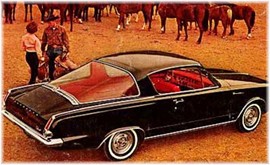 < 1964 Plymouth Barracuda
< 1964 Plymouth Barracuda
Ford's 1965 Mustang >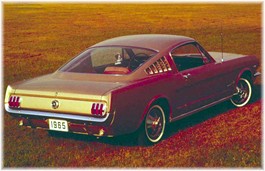
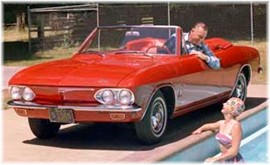 < 1965 Corvair Monza Convertible
< 1965 Corvair Monza ConvertibleIn the face of the V8’s offered in the Mustang and Barracuda, The ’65 Corvair continued to go its own way, offered with normally aspirated and turbocharged pancake engines mounted astern, and adding front disc brakes and a more sophisticated independent rear suspension that abandoned the original car’s swing-axles, for a configuration much like that of the C2 Corvette introduced 2 years earlier. The highest output engine offered in the Corvair was the 180 hp (134 kW) Turbocharged version, well down on ponies to the Mustang, which offered a 210 HP V8 when introduced, bumped up to 271 HP with solid lifters and a 4-barrel carb by the end of the ’65 model run. Plymouth's Barracuda could be optioned with a 235 bhp V8 during the ’65 model year.
Nevertheless, the car rags loved the ’65 Corvair, raving about its styling and handling, though, not surprisingly, wishing for more horsepower. David E Davis, writing in Car and Driver, went so far as to call it “…the most beautiful car to appear in this country since before World War II." While Davis’ statements seem overblown in retrospect, the new car was a radical departure from the original Corvair, a car whose basic styling cues were cribbed by NSU, BMW, and others. The ’65 Corvair incorporated elements of Larry Shinoda’s Monza SS and GT concepts and had subtle hints of Pininfarina's Corvair variants. Featuring a bit of “Coke Bottle” to its shape and foreshadowing the styling of a future Chevy that would be the final nail in the Corvair’s coffin, all 1965 and after closed Corvairs featured pillar-less, hardtop design. (Except for some carryover Greenbrier vans sold to fleets in ’65).
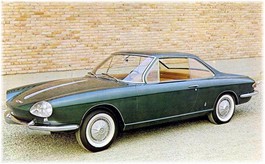
< Pininfarina Corvair
Corvair Monza Studio, circa 1961 >
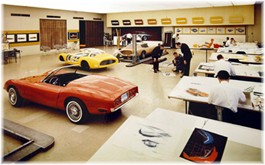
[/size][/b]
A rival to the Mustang and Barracuda - and the Corvair - came from within Chevrolet. GM began work on this new car at the same time the ’65 Corvair’s were being introduced to the buying public. Again feeling the need to catch up with Ford (the Valiant Barracuda had sold only 23,433 units in ’64 and 64,596 units in ’65, and didn’t seem a big threat); GM began to systematically de-emphasize the sporty Corvair versions as hotter Chevy II Nova models were introduced. In 1964, the Chevy II's first factory V8 option was introduced, a 195 hp (145 kW) 283 cu in (4.64 L) V8. In 1965, a 327 cu in (5.36 L) V8 was also available with up to 300 hp (220 kW). But something more would be needed, and work began on clay styling models of the “Panther”, which would be re-named Camaro before going on sale in September 1966.
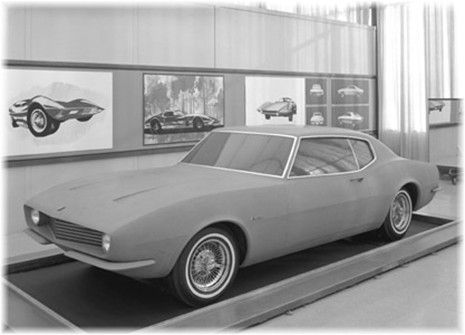 XP-836 “Panther” Clay Model - November, 1964
XP-836 “Panther” Clay Model - November, 1964[/size]
Another development in 1965 that would have serious implications for the rear-engine Chevrolet was the publication of a book that attacked the US automakers for their apparent lack of concern over the safety of their customers. Never mind that Ford tried – and failed – to sell safety as a differentiating feature in the 1950’s, Seattle attorney Ralph Nader was on the scene for the birth of the “consumerist” movement, and his book
Unsafe at Any Speed: The Designed-In Dangers of the American Automobile led off with a chapter titled
The Sporty Corvair (The One-Car Accident), which took GM task for quirky, swing-axle-induced handling of the 1960-64 Corvair.
While the early Corvair handling problems could be largely mitigated by following the tire-inflation instructions in the manual, most gas station attendants were unaware, and many owners never read the manual. The second-generation Corvair’s revised suspension eliminated the tuck-under issue of the earlier cars, but the publicity of the book and GM’s disastrous reaction to the book and Nader would hurt the car's sales through the rest of the decade. GM was accused and found guilty of:
“casting aspersions upon [his] political, social, racial and religious views; his integrity; his sexual proclivities and inclinations; and his personal habits; kept him under surveillance in public places for an unreasonable length of time; caused him to be accosted by girls for the purpose of entrapping him into illicit relationships; made threatening, harassing and obnoxious telephone calls to him; tapped his telephone and eavesdropped, by means of mechanical and electronic equipment, on his private conversations with others; and conducted a "continuing" and harassing investigation”*
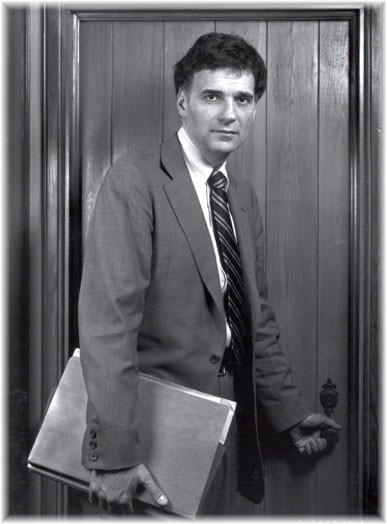 Ralph Nader in 1982
Ralph Nader in 1982And that placed the final piece of the puzzle. The sleek-looking, sweet-handling second-generation Corvair was doomed.
The new cars sold in respectable numbers, at least at first. Over the remaining 1966 through 1969 model years, Chevrolet slowed and then ceased further development of the car, dropped trim levels, eliminated the turbocharged engine, and, eventually, even the 4-door. Starting in 1968, only the 500 and Monza coupe and the Monza convertible were offered. Sales in 1968 dropped to just 15,400 cars. Since they were built in the same plant as the Chevy Nova, which was selling quite well, Corvairs built after November 1968 were mostly hand-assembled in a small area set aside within the huge Willow Run plant. Every Corvair built from that time until the last unit rolled off the line on May 14, 1969, was assembled in the “Corvair Room”.
[/size]
But that was the ignominious end. In the fall of 1964, the future seemed bright for the Corvair, and the aftermarket community was ready to rush in with all manner of go-fast parts, appearance items and completely-new vehicles that used the Corvair as a starting point. I’ll take a look at those in the next installment of this article.
Sources:
Allpar.com
CorvairCorsa.com
Dmoz.org
GM Heritage Collection
Google Books
Nader v. General Motors Corp. Court of Appeals of New York
West Coast Falcons